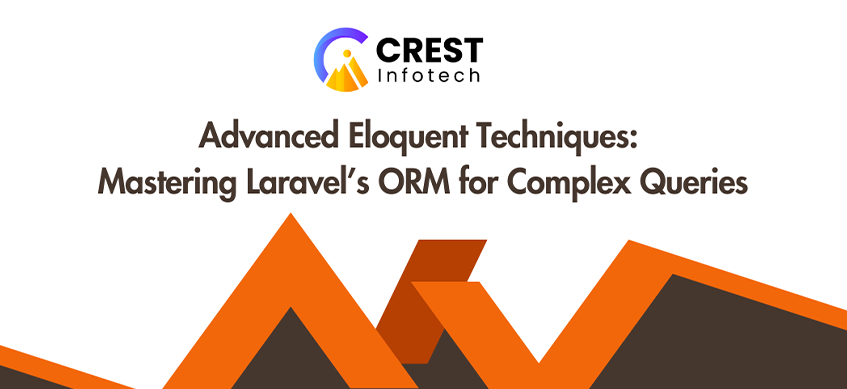Laravel’s Eloquent ORM (Object-Relational Mapping) is one of the most powerful and flexible tools for interacting with databases in PHP. It simplifies database interactions by providing an elegant and intuitive syntax. However, to harness the full potential of Eloquent, especially for complex queries, developers need to go beyond basic Model::find() and Model::where() calls. In this article, we’ll explore advanced Eloquent techniques that allow developers to handle complex relationships, optimize performance, and write concise, readable code.
1. Eager Loading with Constraints
Eager loading allows you to preload relationships in order to avoid the “N+1” problem, where multiple queries are triggered when accessing related models. However, sometimes you only need a subset of related data.
// Loading a user's posts but only where the post status is published
$users = User::with(['posts' => function ($query) {
$query->where('status', 'published');
}])->get();
By using eager loading constraints, you ensure that only the relevant posts are retrieved, reducing query overhead and memory usage.
2. Subqueries and Selects
Eloquent allows you to use subqueries to add calculated or related data directly into the main query result. This is useful when you want to include information like the latest record or an aggregate result.
Example: Adding the latest order for each customer:
$customers = Customer::select('customers.*')
->selectSub(function ($query) {
$query->from('orders')
->select('order_date')
->whereColumn('orders.customer_id', 'customers.id')
->latest('order_date')
->limit(1);
}, 'latest_order_date')
->get();
This query will fetch all customers along with their latest order date.
3. Advanced Relationships: HasManyThrough
The hasManyThrough relationship allows you to define relationships through an intermediary model. This is useful when you need to fetch data from two models that are related through a third one.
Example: Accessing a country’s posts through users:
class Country extends Model
{
public function posts()
{
return $this->hasManyThrough(Post::class, User::class);
}
}
In this example, you can retrieve all posts made by users who belong to a specific country.
4. Polymorphic Relationships
Polymorphic relationships allow a model to belong to more than one other model on a single association. This can be handy for situations like comments on different entities (e.g., posts and videos) or media files attached to various models.
Example: Comments on both Post and Video:
class Comment extends Model
{
public function commentable()
{
return $this->morphTo();
}
}
class Post extends Model
{
public function comments()
{
return $this->morphMany(Comment::class, 'commentable');
}
}
class Video extends Model
{
public function comments()
{
return $this->morphMany(Comment::class, 'commentable');
}
}
Polymorphic relationships make your data model more flexible and reduce the need for redundant tables.
5. Chunking Large Results
When dealing with large datasets, fetching all records at once can lead to memory exhaustion. Eloquent provides a chunk() method that allows you to process large sets of data in smaller chunks.
User::chunk(100, function ($users) {
foreach ($users as $user) {
// Process each user
}
});
By chunking, you ensure that only a small portion of the data is loaded into memory at any given time.
6. Dynamic Scopes
Scopes allow you to encapsulate commonly used query logic within a model. Dynamic scopes, however, provide even more flexibility by allowing you to pass parameters.
Example: Defining a scope for filtering active users:
class User extends Model
{
public function scopeActive($query)
{
return $query->where('active', 1);
}
public function scopeOfType($query, $type)
{
return $query->where('type', $type);
}
}
You can now chain these scopes dynamically in your queries:
$users = User::active()->ofType('admin')->get();This keeps your queries clean and reusable.
7. Mutators and Accessors for Data Transformation
Eloquent provides mutators and accessors to modify data when retrieving it from or storing it into the database. These are useful for formatting data or implementing custom logic.
Example: Formatting a user’s name:
class User extends Model
{
public function getFullNameAttribute()
{
return ucfirst($this->first_name) . ' ' . ucfirst($this->last_name);
}
}
You can now access the full name of a user with:
$user->full_name;This avoids the need to manipulate the user’s name every time it is retrieved.
8. Query Caching
To optimize performance, especially when dealing with complex queries, Eloquent provides caching through packages like laravel-query-cache. You can cache results and avoid querying the database for repeated data.
Example: Caching a query result:
$posts = Cache::remember('posts', 60, function () {
return Post::all();
});
By caching the result for 60 minutes, subsequent requests will retrieve the posts from the cache instead of hitting the database.
9. Raw Expressions and Joins
When Eloquent’s fluent query builder isn’t enough for complex queries, you can fall back on raw SQL expressions. This can be particularly useful when using database-specific functions or performing raw joins.
Example: Using raw expressions for a conditional count:
$users = User::select('name', DB::raw('COUNT(posts.id) as post_count'))
->leftJoin('posts', 'users.id', '=', 'posts.user_id')
->groupBy('users.id')
->get();
This query counts the number of posts for each user and demonstrates how to integrate raw SQL with Eloquent.
10. Handling Soft Deletes with Complex Queries
Soft deletes allow you to mark records as deleted without actually removing them from the database. However, when writing complex queries, you need to ensure that soft-deleted records are handled properly.
Example: Querying soft-deleted records:
$users = User::withTrashed()->where('status', 'inactive')->get();
To only fetch soft-deleted records:
$deletedUsers = User::onlyTrashed()->get();This gives you control over how to handle deleted records in complex queries.
Conclusion
Laravel’s Eloquent ORM provides a rich set of features that go far beyond basic CRUD operations. By mastering advanced techniques such as eager loading with constraints, subqueries, polymorphic relationships, and query chunking, you can handle even the most complex database interactions efficiently. With these tools, you can write clean, maintainable, and performant queries while leveraging the full power of Laravel’s expressive syntax.



